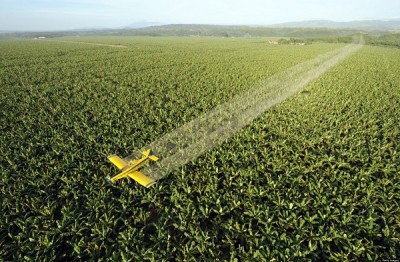
Image source: NBC News
The EPA wants to expand the use of two pesticides that could be a major threat to America’s bee population, farms and the nation’s food supply. That’s the charge being made by the Center for Food Safety and beekeepers.
The agency is proposing more uses for thiamethoxam, a pesticide that has been banned in the European Union because it is considered a threat to bees. A letter from the Center to the Environmental Protection Agency raises some serious concerns about thiamethoxam and another pesticide, sulfoxaflor.
“Peer-reviewed scientific studies have consistently shown that these systemic chemicals are highly toxic to honeybees, other pollinators and beneficial insects,” the letter states. “Pollinator losses represent a serious threat to the agricultural industry and food security. Furthermore, these systemic pesticides have also been shown to negatively impact beneficial insects and contaminate water bodies and soil.”
The Threat from Neonic Pesticides
Thiamethoxam and sulfoxaflor are neonic or neonicotinoid pesticides which studies have tied to bee deaths, as Off The Grid News has reported. Last year scientists from Health Canada (Canada’s Department of Health) found 70 percent of bees that died from colony collapse tested positive for neonicotinoids. A Harvard study this year also tied bee deaths to neonicotinoids.
“They’re taking in something that they will ultimately die from, and they’re taking this into the hive and feeding on it all winter, then we wonder why we have winter mortality,” Madeline Chagnon, an environmental scientist at the University of Quebec, said of bees and the pesticides.
Chagnon says the pesticides enter the soil when they are coated on seeds. The soil then becomes dusty and is stirred up during agricultural processes. The dust exposes the bees to the pesticides and eventually kills them. Bees can also become exposed to the chemicals while pollinating crops.
Pesticides In the Water, Too
There is also evidence that neonicotinoids can contaminate water. University of Saskatchewan biologist Christy Morrissey told the CBC that 80 to 90 percent of water in wetlands next to farms where the pesticides were used is contaminated with the chemicals.
Story continues below video
“You should be aware that these compounds are much more toxic and are in the water far longer than other insecticides used on the market,” Morrissey said. “So they [bees] basically are being hit continuously with the chemical.”
Bees are not the only animals being affected; Morrissey believes that neonicotinoids could also be affecting birds, because birds eat the seeds coated with the chemicals.
Suspended in Europe But Expanded in America
The European Union’s Food Safety Authority suspended the use of thiamethoxam and sulfoxar on Dec. 1, 2013 because they pose “high-acute” risks for bees. Two companies that manufacture and market the toxins, Bayer and Syngenta, have sued the EU in an attempt to overturn the suspension.
The EPA is considering more uses for the chemicals and took comments through Tuesday. The Center for Food Safety and other groups are circulating a petition asking the agency not to take that move. The Center has also sued the EPA in an attempt to stop the approval.
Pesticide Makers Accused of Tobacco-Like Tactics
 Pesticide makers, including Bayer, Syngenta and Monsanto, are using propaganda tactics similar to those the tobacco industry used to defend cigarettes in order to deflect criticism of neonics and to keep profiting from them, the Center for Media and Democracy is alleging.
Pesticide makers, including Bayer, Syngenta and Monsanto, are using propaganda tactics similar to those the tobacco industry used to defend cigarettes in order to deflect criticism of neonics and to keep profiting from them, the Center for Media and Democracy is alleging.
“Their goals: manufacture doubt about their products’ contribution to the bee crisis and delay action, or defeat bans or limits on neonic pesticides, in order to allow them to continue profiting from these products as long as possible,” a Center press release said of the three companies.
The tactics involve promoting bee care and distributing a children’s book that tries to blame bee die offs on mites rather than pesticides, the Center is alleging. The reason for the effort is simple money: Bayer alone reportedly makes $1.5 billion from neonic pesticides.
“I think we’re into neonics so deep … because chemical companies are making billions of dollars on the usage of these products,” Ontario beekeeper Jim Coneybeare said of the situation.
Do you believe neonicotinoids kill bees? Let us know in the comments section below.
Sign up for Off The Grid News’ weekly email and stay informed about the issues important to you
 Off The Grid News Better Ideas For Off The Grid Living
Off The Grid News Better Ideas For Off The Grid Living




